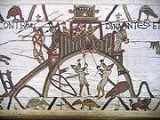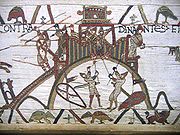
The Last English King
Encyclopedia
The Last English King is a historical novel
by English
writer
Julian Rathbone
. The novel covers the time of the Battle of Hastings
. It revolves around Walt Edwinson, a housecarl
of Harold Godwinson
, the last Anglo-Saxon
king of England. The story starts with Walt returning to his home at Iwerne
in Dorset
four years after the Battle of Hastings. He had fled England after the defeat of the Anglo-Saxons and had spent the time travelling across Europe
and Asia Minor
. The story of his journey from Constantinople
via Nicomedia
and Nicaea
to Side
is then recounted in parallel with his recollections of the time before the battle, such as his accompanying Harold to William of Normandy's attack on Dinan
.
 At the end of novel the death of Harold is described. Rathbone has him buried in a shroud made from a banner depicting the "Fighting Man of Cerne
At the end of novel the death of Harold is described. Rathbone has him buried in a shroud made from a banner depicting the "Fighting Man of Cerne
".
Historical novel
According to Encyclopædia Britannica, a historical novel is-Development:An early example of historical prose fiction is Luó Guànzhōng's 14th century Romance of the Three Kingdoms, which covers one of the most important periods of Chinese history and left a lasting impact on Chinese culture.The...
by English
English people
The English are a nation and ethnic group native to England, who speak English. The English identity is of early mediaeval origin, when they were known in Old English as the Anglecynn. England is now a country of the United Kingdom, and the majority of English people in England are British Citizens...
writer
Writer
A writer is a person who produces literature, such as novels, short stories, plays, screenplays, poetry, or other literary art. Skilled writers are able to use language to portray ideas and images....
Julian Rathbone
Julian Rathbone
Julian Christopher Rathbone was an English novelist.- Life :Julian Rathbone attended Magdalene College, Cambridge, where he was a contemporary of Bamber Gascoigne and Sylvia Plath. At Cambridge he took tutorials with FR Leavis, for whom, without having ever been what might be described as a...
. The novel covers the time of the Battle of Hastings
Battle of Hastings
The Battle of Hastings occurred on 14 October 1066 during the Norman conquest of England, between the Norman-French army of Duke William II of Normandy and the English army under King Harold II...
. It revolves around Walt Edwinson, a housecarl
Housecarl
In medieval Scandinavia, housecarls and sometimes spelled huscarle or houscarl) were either non-servile manservants, or household troops in personal service of someone, equivalent to a bodyguard to Scandinavian lords and kings. This institution also existed in Anglo-Saxon England after its...
of Harold Godwinson
Harold Godwinson
Harold Godwinson was the last Anglo-Saxon King of England.It could be argued that Edgar the Atheling, who was proclaimed as king by the witan but never crowned, was really the last Anglo-Saxon king...
, the last Anglo-Saxon
Anglo-Saxons
Anglo-Saxon is a term used by historians to designate the Germanic tribes who invaded and settled the south and east of Great Britain beginning in the early 5th century AD, and the period from their creation of the English nation to the Norman conquest. The Anglo-Saxon Era denotes the period of...
king of England. The story starts with Walt returning to his home at Iwerne
Iwerne Minster
Iwerne Minster is a village in North Dorset, England, situated under Cranborne Chase in the Blackmore Vale just off the A350. The village has a population of 889 . A cheese shop employs 57 persons...
in Dorset
Dorset
Dorset , is a county in South West England on the English Channel coast. The county town is Dorchester which is situated in the south. The Hampshire towns of Bournemouth and Christchurch joined the county with the reorganisation of local government in 1974...
four years after the Battle of Hastings. He had fled England after the defeat of the Anglo-Saxons and had spent the time travelling across Europe
Europe
Europe is, by convention, one of the world's seven continents. Comprising the westernmost peninsula of Eurasia, Europe is generally 'divided' from Asia to its east by the watershed divides of the Ural and Caucasus Mountains, the Ural River, the Caspian and Black Seas, and the waterways connecting...
and Asia Minor
Asia Minor
Asia Minor is a geographical location at the westernmost protrusion of Asia, also called Anatolia, and corresponds to the western two thirds of the Asian part of Turkey...
. The story of his journey from Constantinople
Constantinople
Constantinople was the capital of the Roman, Eastern Roman, Byzantine, Latin, and Ottoman Empires. Throughout most of the Middle Ages, Constantinople was Europe's largest and wealthiest city.-Names:...
via Nicomedia
Nicomedia
Nicomedia was an ancient city in what is now Turkey, founded in 712/11 BC as a Megarian colony and was originally known as Astacus . After being destroyed by Lysimachus, it was rebuilt by Nicomedes I of Bithynia in 264 BC under the name of Nicomedia, and has ever since been one of the most...
and Nicaea
Iznik
İznik is a city in Turkey which is primarily known as the site of the First and Second Councils of Nicaea, the first and seventh Ecumenical councils in the early history of the Church, the Nicene Creed, and as the capital city of the Empire of Nicaea...
to Side
Side
Side was an ancient Greek city in Anatolia, in the region of Pamphylia, in what is now Antalya province, on the southern Mediterranean coast of Turkey...
is then recounted in parallel with his recollections of the time before the battle, such as his accompanying Harold to William of Normandy's attack on Dinan
Dinan
Dinan is a walled Breton town and a commune in the Côtes-d'Armor department in northwestern France.-Geography:Its geographical setting is exceptional. Instead of nestling on the valley floor like Morlaix, most urban development has been on the hillside, overlooking the river Rance...
.

Cerne Abbas giant
The Cerne Abbas Giant, also referred to as the Rude Man or the Rude Giant, is a hill figure of a giant naked man on a hillside near the village of Cerne Abbas, to the north of Dorchester, in Dorset, England. The high, wide figure is carved into the side of a steep hill, and is best viewed from...
".

